How American Racism Sabotaged the World’s Fight Against Genocide
The international laws against genocide were deliberately crafted to prevent the US from being held accountable for its crimes against Black and Indigenous people.
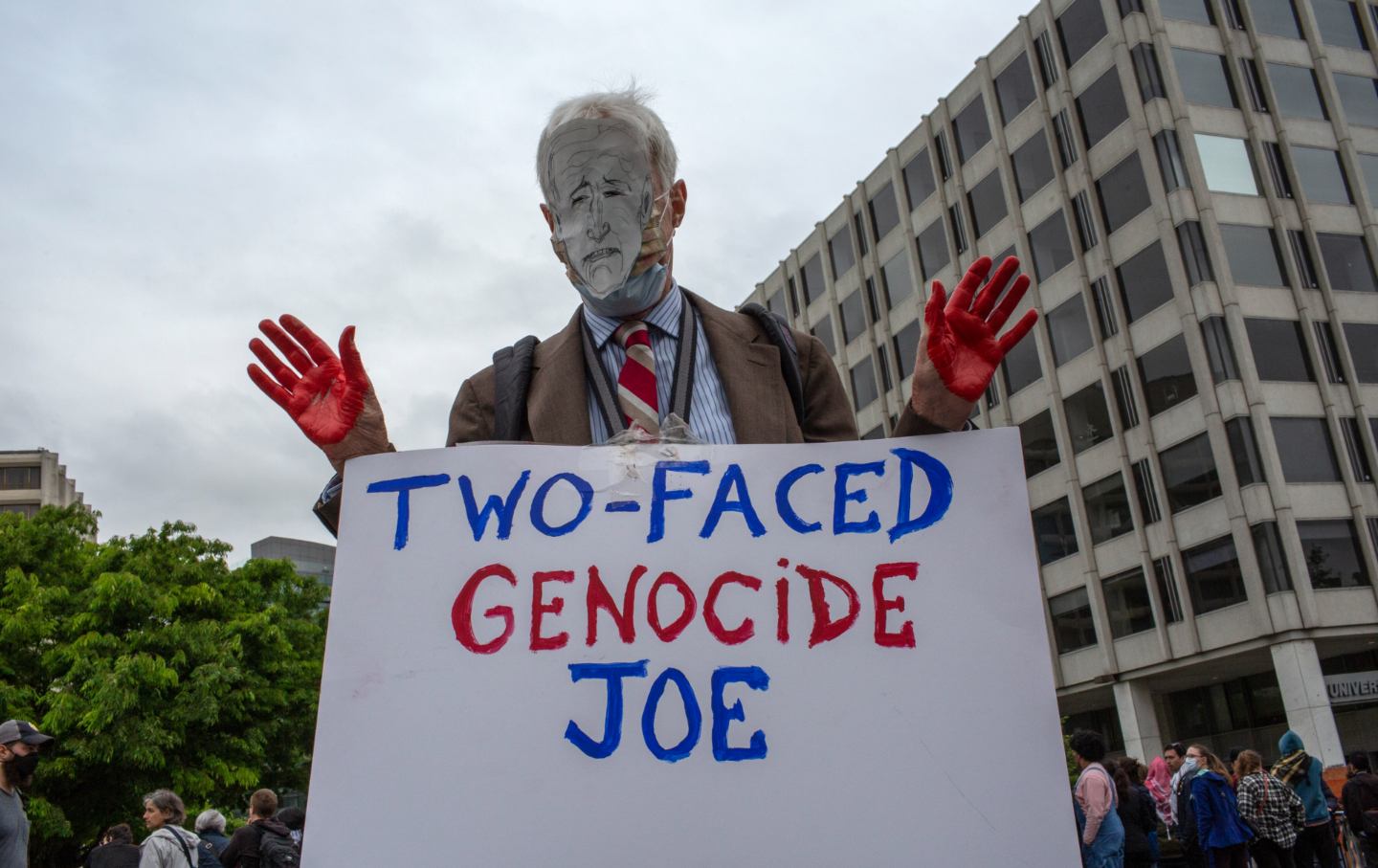
An anti–Joe Biden sign from a protest outside the White House Correspondents’ Dinner on April 27, 2024.
(Probal Rashid / LightRocket via Getty Images)On November 3, 2023, roughly a month into the war in Gaza, Democratic Representative Rashida Tlaib, the only Palestinian American in Congress, posted a searing video to X, formerly known as Twitter. The video accused President Biden of supporting “the genocide of the Palestinian people.”
Though the discussion around whether Israel’s assault on Gaza constituted genocide had been raging since the beginning of the conflict, the mainstream media had mostly avoided the question. But a sitting member of Congress from Biden’s own party charging him with abetting genocide was harder to overlook.
Thus, when White House deputy national security adviser Jon Finer appeared on ABC’s This Week the Sunday after Tlaib posted her video, host George Stephanopoulos asked him to respond to Tlaib’s condemnation.
“Look, we strongly disagree with some of that messaging and with some of the terms used to describe this conflict,” Finer said. “Some of the characterizations and the terms used we believe have technical definitions, have certain historical resonance and weight, and that we do not accept their application to this particular war even as we continue to raise our serious concerns about the toll that this is taking on civilian life and the need to do even more to protect it.”
Finer was partially correct. There are technical definitions for genocide, and the term does have historical resonance. It was in the shadow of the Holocaust, the genocide that has been given more historical resonance than any other, that the 1948 Convention on the Prevention and Punishment of the Crime of Genocide, which enshrined the international legal framework around genocide, was created.
But when you cut through the vagueness, Finer appeared to be saying that the “weight” of the word “genocide” is entombed in the history of the Holocaust. Under this premise, genocide is an immutable term, and applying it where it does not belong defiles the memory of the Holocaust and dilutes the meaning of international law.
Those comments underscored an uglier reality. International law is not a transcendent decree made in the image of divine justice. The law is made in the image, desires, and interests of those with power. And as the foremost world power, the United States has frequently ensured that international law works in ways that do not impede its global agenda, or that of its allies.
In fact, the very creation of the Genocide Convention was marked by this imperial self-interest. During its drafting phase, the US worked to successfully guarantee that the ultimate definition of genocide would shield its government from being charged with the genocide of Black Americans. In other words, the international response to the worst crime against humanity was indelibly shaped by American white supremacy.
Now, 77 years after the convention was ratified, the effects of America’s continued desire to deny the depths of its crimes against Black people have helped make it possible for President Biden and the government he has led to pretend, even in their final days, that the genocide of Palestinians is not happening.
In 1944, Raphael Lemkin, a Polish lawyer of Jewish descent, published Axis Rule in Occupied Europe: Laws of Occupation Analysis of Government, Proposals for Redress. Axis Rule chronicled Nazi Germany’s inhumane methods of occupation during their military conquest of Europe. Before Axis Rule, there was no universal word that described the atrocities Hitler’s totalitarian regime inflicted on Europe. To invent such a term, Lemkin combined the Greek word genos (race, tribe) with the Latin suffix cide (killing) and coined a word that encompassed the totality of the horrors occupied populations experienced under the Third Reich: genocide.
“Generally speaking, genocide does not necessarily mean the immediate destruction of a nation, except when accomplished by mass killings of all members of a nation,” Lemkin wrote. “It is intended rather to signify a coordinated plan of different actions aiming at the destruction of essential foundations of the life of national groups, with the aim of annihilating the groups themselves.”
After the war’s end, the newly formed United Nations decided to craft an international treaty defining both the crime of genocide and the punishment for those who committed it. The resolution establishing the drafting of the treaty passed unanimously.
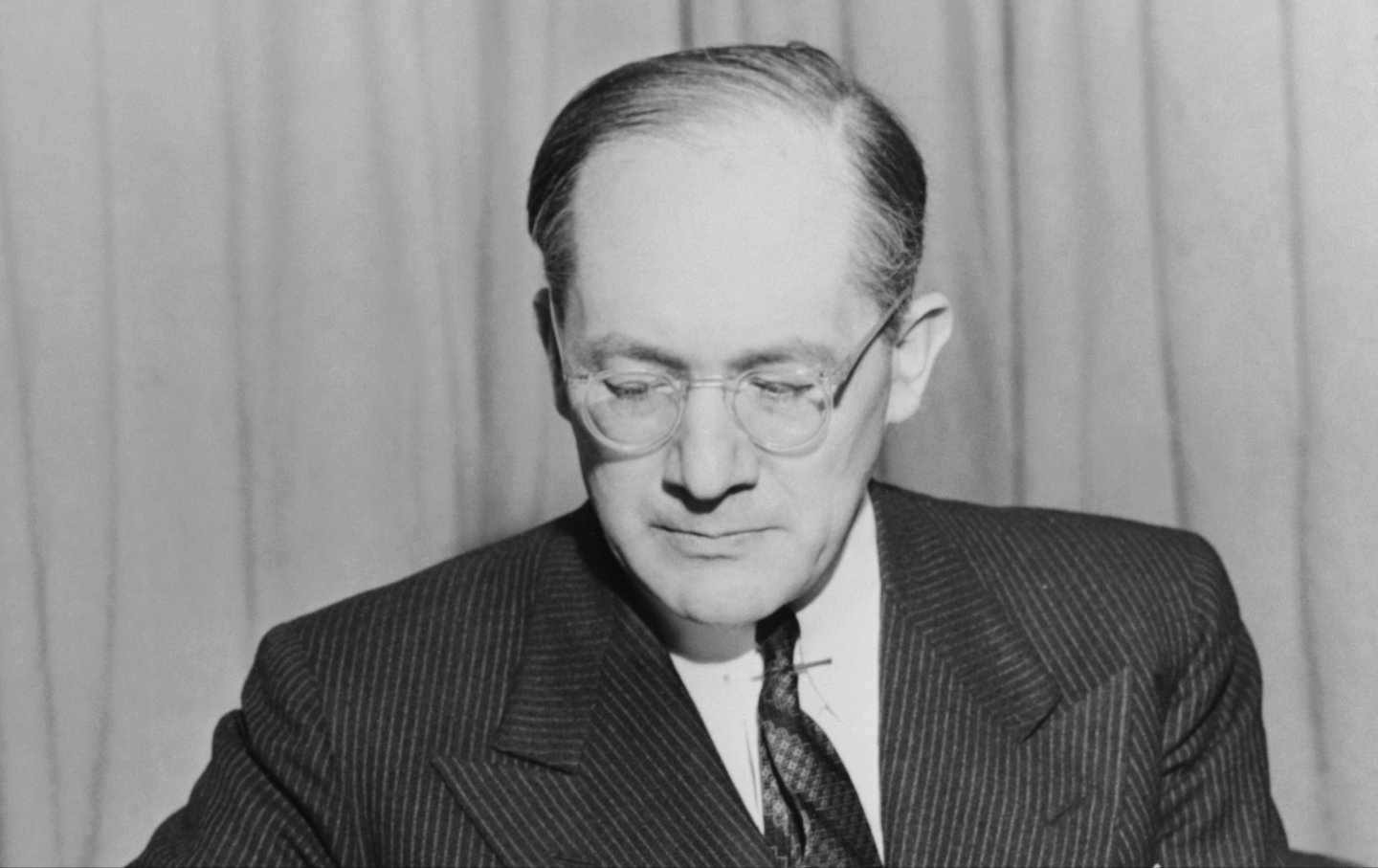
The final version states that any of the following acts committed with “intent to destroy, in whole or in part, a national, ethnical, racial or religious group” constitute a genocide:
- Killing members of the group;
- Causing serious bodily or mental harm to members of the group;
- Deliberately inflicting on the group conditions of life calculated to bring about its physical destruction in whole or in part;
- Imposing measures intended to prevent births within the group;
- Forcibly transferring children of the group to another group.
However, as with so much of the development of the UN, the convention’s text was heavily influenced by the United States, which was beginning its era of postwar global dominance. (The US was frank about its desire to build the UN from the ground up in a way that would allow Americans to avoid accountability for their atrocities. Edward Stettinius Jr., the chairman of the United States delegation to the United Nations Conference, made it clear that his “job in San Francisco was to create a charter…not to take up subjects like…‘the negro question.’”)
During the convention’s drafting phase, the US State Department proposed substantial modifications to the definition of genocide.
One American objection concerned a clause in the May 1947 draft of the convention outlawing “cultural genocide,” defined as “any deliberate act committed with the intent to destroy the language, religion, or culture of a national, racial, or religious group on grounds of the national or racial origin or the religious beliefs of its members.”
As Douglas Irvin-Erickson, the director of the Genocide Prevention Program at the Carter School for Peace and Conflict Resolution at George Mason University, explained to The Nation, the Americans had ample reasons to be worried about the potential ramifications of this clause. From the forced assimilation campaigns designed to erase Indigenous cultures to the all-encompassing white supremacist terror of the Jim Crow South, it was all too easy to think of ways the Genocide Convention could be deployed against the US.
The Americans did not attempt to hide their motivations.
In a September 10, 1947, memorandum, the State Department said, “The United States disapproves the inclusion of ‘cultural genocide’ (suppression of language, books, cultural monuments, etc.) as an offense.” US Delegates Ernest Gross and Dean Rusk cautioned the department that “sporadic outbreaks against the Negro population of the United States may be brought to the attention of the United Nations.”
The US was not alone: Other countries, like France, the Netherlands, and Egypt all expressed concerns about the cultural genocide clause.
“There’s broad support for erasing any kind of Black experience from the convention,” Irvin-Erickson said. “It’s linked to great powers that are trying to make sure that the kinds of violence and oppressive acts that occur within their own borders fall outside of the legal definition of genocide, while at the same time outlawing the kinds of violence that the geopolitical enemies are committing inside their borders.” The United States and its allies won the argument to remove cultural genocide from the draft by a vote of 25 to 16.
There were other objections as well. As one April 1948 State Department memo reported, American delegates were instructed to block a definition of genocide that “includes individual murders or lynchings” so that senators from Southern states with long histories of anti-Black lynchings would not vote against ratifying the treaty. (The Senate wound up halting ratification anyway, refusing to accede to the treaty for another 40 years.)
The State Department also proposed adding a “complicity clause” to the definition of genocide so that only crimes “committed with the complicity of the responsible officials of a state” could be prosecuted. In other words, unless there was evidence that government leaders were explicitly directing genocidal violence—a standard that the US clearly thought could not be met as far as its own crimes were concerned—there was no case.
Once the State Department recognized that other nations opposed the “complicity” clause, the US delegation “compensated” by proposing a provision in the spirit of the “complicity” clause. The proposal forbade an international tribunal from levying a charge of genocide against a nation unless the tribunal found evidence that the government in which an alleged genocide occurred “failed to take adequate measures to punish the crime.”
The United States also ferried a crucial element into the definition that has had profound implications on its response to the Gaza genocide: the concept of “intent.”
In Chapter 9 of Axis Rule, where Lemkin outlines his formulation of the word genocide, “intent” does not appear as a prerequisite. It also does not appear in the June 6, 1947, Draft Convention, which defined genocide as “criminal acts against any one of the groups of human beings aforesaid, with the purpose of destroying them in whole or in part, or of preventing their preservation or development.”
On September 30, 1947, the United States responded to the Secretariat draft: “Attention is called to the fact that the important matter of ‘intent’ is injected into the definition contained in the preamble by the inclusion of the phrase ‘intentional destruction,’ which in any event might better read “deliberate destruction or attempt to destroy.’”
While there was broad consensus on inserting “intent” into the definition, there was notable caution. The Netherlands did not object to including the element of “purpose” into the definition of genocide, but it warned about the possibility that an unchecked “intent” clause would allow “camouflaged genocide”: “It will have to be established beyond doubt, however, that so-called camouflaged genocide will equally be punishable; this covers cases in which the defendant might plead that the incriminated action, although it did in fact lead to the destruction or frustration of a group, was not aimed against that group.”
Despite these concerns, the intent clause made it into the final version of the convention, which was ratified into international law on December 9, 1948.
Two years later, the United States Committee for the Genocide Convention addressed a brief to the Senate supporting President Truman’s order to ratify the Genocide Convention into federal law. The brief highlighted how the stringent demands created by the intent clause excluded lynching and race riots from the law’s jurisdiction: “There could be no jurisdiction to try perpetrators of a race riot on the charge of genocide save on proof that the acts were committed as part of a plan to destroy an entire religious, racial, or national group. The evidence required to establish such an ‘intent to destroy’ would be enormous.”
The brief also contained a footnote that acknowledged America’s influence on the Genocide Convention: “The United States was responsible for the inclusion of an intent element to the crime of genocide.”
The attempt to separate Black suffering from genocide is long-lasting—and implicates even modern politicians like President Biden. During Biden’s 2020 presidential campaign, he appealed to the need for countrywide “unity” by highlighting his ability to work with an avowed segregationist, Herman Talmadge. “At least there was some civility. We got things done,” Biden said, after calling Talmadge “one of the meanest guys” he ever knew.
Talmadge, a Jim Crow advocate, was a member of the Sons of Confederate Veterans, a Confederate heritage group that embraced the Lost Cause as gospel, preached the nobility of Confederate soldiers, and bolstered the Ku Klux Klan. Talmadge’s incitement of anti-Black violence was so prevalent in the 1940s that he was named in a 1951 petition that accused the United States of committing acts of genocide toward Black Americans.
In 1951, the Civil Rights Congress (CRC) published We Charge Genocide, a 240-page petition addressed to the United Nations, accusing the United States of genocide. “We maintain…,” the petition begins, “that the oppressed Negro citizens of the United States, segregated, discriminated against and long the target of violence, suffer from genocide as the result of the consistent, conscious unified policies of every branch of government.”
Popular
“swipe left below to view more authors”Swipe →The CRC named Talmadge, then the governor of Georgia, in the petition and indicted him in its opening statement for “inciting genocide” of Black Americans during an October 22, 1949, radio address. “We will fight them in the counties and the cities…,” Talmadge said. “We intend to fight hand to hand with all our weapons, and we will never submit to one inch of encroachment on our traditional pattern of segregation.”
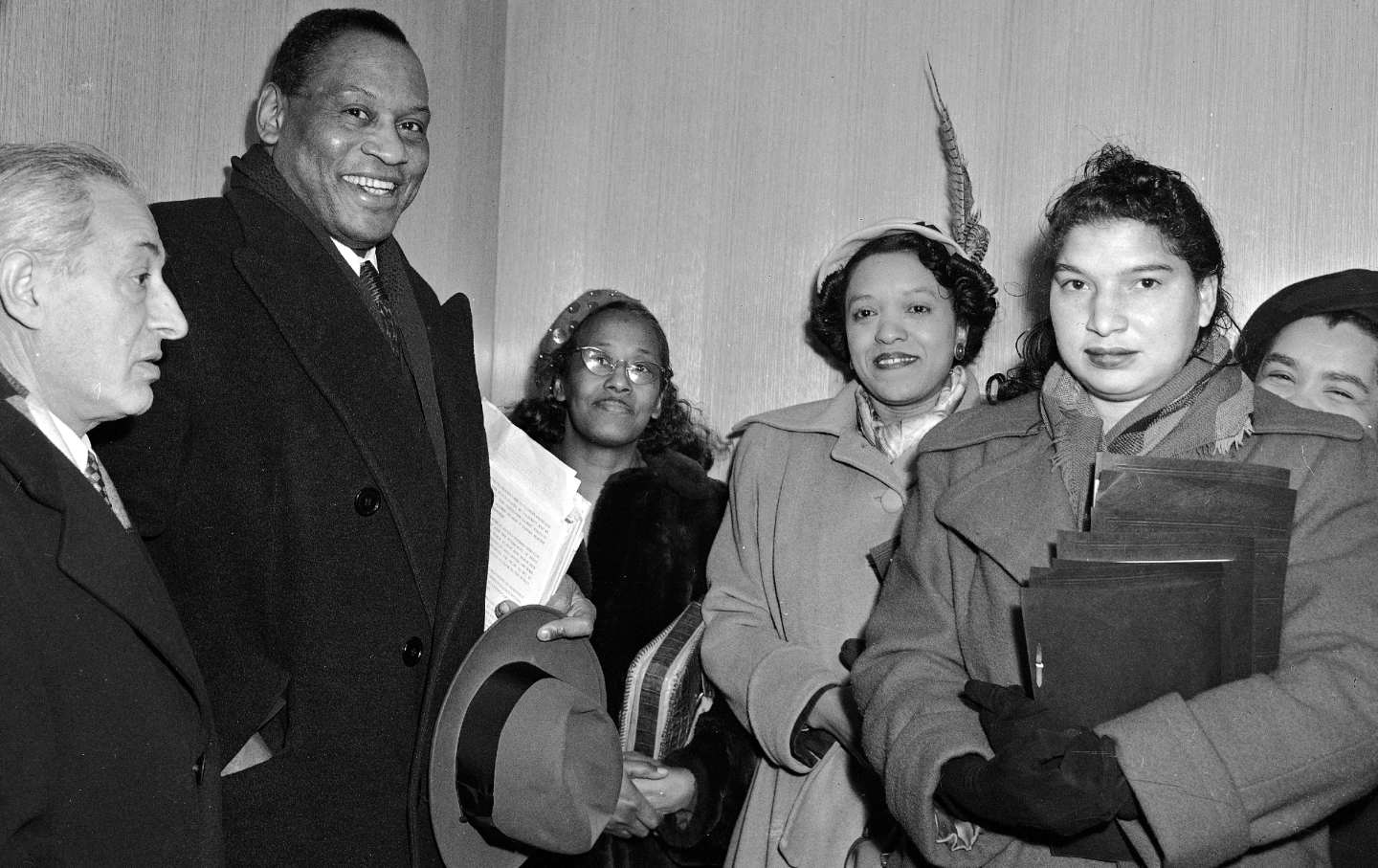
The petition also cited the Georgia murder of Isaiah Nixon, who was shot and killed by two white men, brothers Johnnie and Jim Johnson, in 1948 after Nixon exercised his legal right to vote. The Johnson brothers were indicted and later acquitted by an all-white jury, after the defendants said they did not go to Nixon’s house with the intent of killing him.
It is worth noting that We Charge Genocide not only used lynching and mass murder as examples of the United States’ genocidal practices. The CRC meticulously listed various genocidal policies the American government imposed on 15 million of its Black citizens, sorting them according to the articles of the UN Genocide Convention that the CRC determined had been violated. These included over 100 instances of US government complicity in the Ku Klux Klan’s campaign to purge Black votes from the electorate and over 500 violations of Articles II and III of the Genocide Convention, including lack of access to life-saving services like hospitals, and rampant housing discrimination that imprisoned Black Americans in slums and ghettos that resulted in an eight-year gap between Black life expectancy and that of white Americans. (As of 2022, the gap was just under five years.)
For the CRC, the oppression of Black Americans was not the result of “negligence.” The genocide of Black Americans was a plan.
In We Charge Genocide, the CRC cited passages from “To Secure These Rights”, a 1947 report mandated by President Truman on the protection of civil rights in America. The report confirmed the CRC’s assertion that the genocide of Black Americans was the intended result of policy and deliberate choices by Americans:
Discrimination in housing results primarily from business practices. These practices may arise from special interests of business groups, such as the profits to be derived from confining minorities to slum areas, or they may reflect community prejudice.…
The communities in which lynchings occur tend to condone the crime. Punishment of lynchers is not accepted as the responsibility of state or local governments in these communities. Frequently, state officials participate in the crime, actively or passively.…
Many hospitals will not admit Negro patients. The United States Public Health Service estimates on the basis of a preliminary survey that only approximately 15,000 hospital beds out of a total of one and one-half million beds are presently available to Negroes. Thus, though Negroes constitute about ten percent of the population, only one percent of the hospital beds are open to them.
“It is the result of the actions of human beings willfully acting together to write and physically, economically and judicially sustain racist law that deprives the Negro people of their right to vote or to organize for their political and economic advancement,” the CRC said. “It is the result of a conspiracy, we repeat, to commit genocide for profit, a conspiracy engineered and directed by monopoly and executed by its state power on a federal, state, county and municipal level.
On December 17, 1951, William Patterson, the national executive of the Civil Rights Congress, delivered We Charge Genocide to the Office of the UN Secretary General. The US response to the CRC petition would be familiar to anyone watching the American reaction to the Gaza genocide today.
Eleanor Roosevelt, then serving as the chair of the UN Human Rights Commission, said We Charge Genocide was “ridiculous in terms of the UN definition.” As the Associated Negro Press reported, “Her reasons were (1) although the Negro death rate is high in America, so is the birth rate, (2) although sickness and disease affect more colored people than other groups, a real effort is being made to overcome this.”
In 1953, Lemkin himself dismissed the charge of genocide in a letter to The New York Times. “By no stretch of imagination can one discover in the United States an intent or plan to exterminate the Negro population, which is increasing in conditions of evident prosperity and progress,” Lemkin wrote. “The tragically dramatic nature of genocide should not be permitted to be deflated. By confusing genocide with discrimination injustice is done not only to existing international law but also to the good name of some democratic societies which might be unjustly slandered for genocide.”
Decades later, defenders of Israel use Palestinian birth rates to fend off charges of genocide, and the “intent” clause is still being exploited. During a May 13, 2024, White House briefing, national security adviser Jake Sullivan rejected the “proposition” that Israel has committed acts of genocide on Palestinians. “We do not believe what’s happening in Gaza is a genocide,” said Sullivan, adding, “We’re using the internationally accepted term for genocide, which includes a focus on intent.”
Lemkin’s betrayal of Black Americans was rooted in part in the intransigence of the institution Biden reveres most: the United States Senate. “Contracting parties” of the Genocide Convention are required to enact legislation in their country to make genocide a crime and “provide effective penalties for persons guilty of genocide.” The United States’ signature on the UN Genocide Convention would be inconsequential until America made genocide a federal crime, which required a majority vote by the Senate.
A Committee on Foreign Relations subcommittee held hearings on ratifying the Genocide Convention in January and February 1950. Proponents of ratification assured that the UN definition could not be used in the United States. “Genocide has never existed in this country. Under our form of government, it can never exist. Our Constitution and our Bill of Rights contain guarantees of the status and rights of minorities which make anything approaching genocide impossible,” said Phillip Perlman, then the solicitor general, at a Senate hearing in January.
Dean Rusk, a Southerner then serving as deputy undersecretary of state, echoed Perlman at the hearing, saying, “Genocide as defined in this convention, has never occurred in the United States and is not likely to occur here in the future.” A New York Times piece covering the hearing noted that the Truman administration’s “first step” to convince the Senate was to “put at rest Southern fears that lynching could be defined as genocide.”
Indeed, the US would legislate that prophecy into reality by amending the definition of genocide. The Proxmire Act defined genocide as the “specific intent to destroy in whole or substantial part, a national, ethnic, racial, or religious group.”
Lemkin had grown exasperated by the Senate’s delay in ratifying the Genocide Convention and did not want to avow any position that would halt ratification. Even before the CRC published We Charge Genocide, Lemkin reinforced the view that the Genocide Convention did not encompass lynching, rape, or violent segregation.
In an April 1950 letter, Lemkin wrote that “lynching is…an act of local terrorism which intends to frighten away local Negroes from doing certain things which the whites do not like them to do. The basic policy of the South is not to destroy the Negro but to preserve the race on a different level of existence.” Lemkin also noted that “destruction in part must be of a substantial nature.”
Dirk Moses, author of the 2021 book The Problems of Genocide and historian of genocide at the City College of New York, said in an interview that this parsing of criminality is one of the problems with genocide law. “The genocide concept has backfired because people are looking for a very particular type of intent, which is virtually impossible to prove in a court of law.” Moses said. “How did Lemkin construct a particular crime that illuminates some aspects of state excess, but obscures others?”
As Moses explained, Lemkin’s site of origin for genocide is the Holocaust, Nazi Germany’s mass execution of 6 million Jews. Although Lemkin wrote in Axis Rule that genocide is “an old practice,” he did not include the constituents of American slavery or the apparatus of Jim Crow in his chronicle of genocidal practices.
Perhaps Lemkin overlooked that the goal of the genocide of Black Americans was not extermination; rather, that Black Americans comprised a class of humans whose purpose is to perpetually experience genocide to reaffirm the US policy of white over Black. As the CRC wrote in We Charge Genocide, “The murder practiced against us then was partial and selective. A limited genocide meant not so much to exterminate us—America still had a job for ‘good niggers‘ to do—as to warn us to correct us, to use those of us who would not submit as examples of what could happen to the rest of us.”
Because the Holocaust demarcates our collective understanding of genocide, we have limited the legibility of genocide to one strand of grotesque violence and obscured the suffering of oppressed groups who might be experiencing genocide-like conditions as an inescapable calamity of war. “They sort of shrug their shoulders and say war is hell,” said Moses. “That’s how it goes. And so we’ve reached, I think in the Gaza conflict.”
While the United States signed the Genocide Convention on December 11, 1948, it failed to ratify it for another 40 years. In 1962, the US State Department acknowledged that the core impediment was “purely political,” the result of “irrational Southern opposition to signing anything that deals with race relations.”
The disregard for white mobs who unrepentantly lynched Black Americans was aired in the House and Senate chambers, where a group of Southern Democrats worked to block anti-lynching legislation—some of whom were delegates to the United Nations General Assembly and heavily involved in shaping American foreign policy with the United Nations.
One delegate, former US Supreme Court justice and secretary of state James F. Byrnes, opposed federal anti-lynching legislation and blocked a Senate investigation of a South Carolina lynching, saying that “rape is responsible, directly and indirectly, for most of the lynching in America.” Texas Senator Tom Connally chaired the Senate Foreign Relations Committee and manned the process of ratifying the US participation in the UN and the Genocide Convention. Using the power of the filibuster, Connally led the Southern opposition to anti-lynching legislation and worked to delay ratifying the Genocide Convention into US law.
The United States did not become a party to the convention until November 1988, after the passage of the Genocide Convention Implementation Act of 1987, also known as the Proxmire Act. The senator who introduced that bill? Joe Biden.
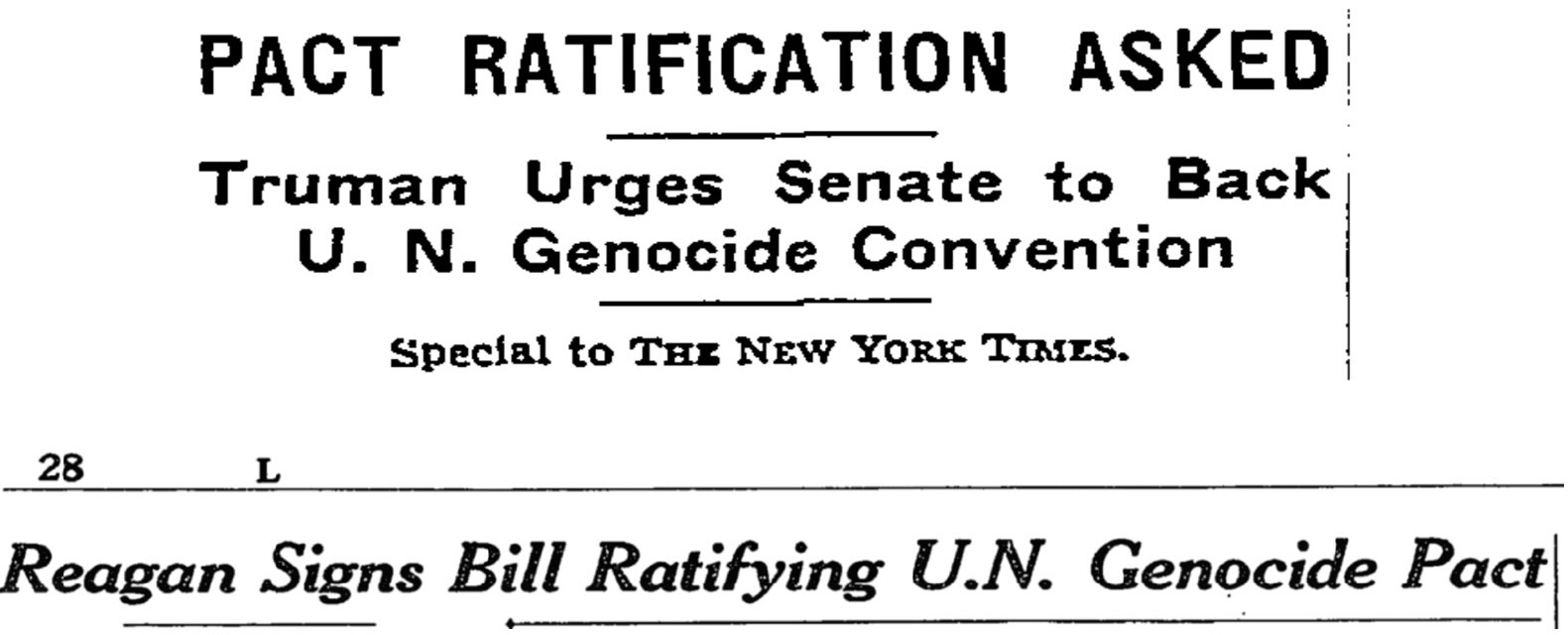
In January 2024, Biden spoke at Emanuel AME Church in Charleston, South Carolina, and briefly narrated how the “poison” of white supremacy has “ripped” America apart throughout history. “After the Civil War, the defeated Confederates couldn’t accept the verdict of the war: They had lost,” Biden said. “They embraced what’s known as the Lost Cause, a self-serving lie that the Civil War was not about slavery but about states’ rights.”
Biden has spoken about white supremacy as if he had forgotten that it explains why he was able to pass a bill that was first introduced to the Senate when he was 6 years old. The Confederacy spawned the Lost Cause, which begat Jim Crow, an afterlife of slavery, and Jim Crow supporters helped give birth to the United Nations and the Genocide Convention. Put differently, it is untenable to confine the rationale of inflicting and erasing anti-Black violence within US borders. It is an error Biden has repeatedly made.
In 2009, 62 years after “To Secure These Rights,” the United States Senate passed a resolution that apologized for the enslavement of African Americans. The acts listed in the apology mirror the constituents of genocide listed at the beginning of this essay. Of course, the American resolution does not refer to those crimes as genocide (neither did “To Secure These Rights”); however, reading the sins enumerated in the apology, it is easy to see the result of the crime committed by a government “who legally recognized slavery through the Constitution and the laws of the United States”:
Whereas Africans forced into slavery were brutalized, humiliated, dehumanized…;
Whereas many enslaved families were torn apart after family members were sold separately;…
Whereas after emancipation from 246 years of slavery, African-Americans soon saw the fleeting political, social, and economic gains they made during Reconstruction eviscerated by virulent racism, lynchings, disenfranchisement, Black Codes, and racial segregation laws that imposed a rigid system of officially sanctioned racial segregation in virtually all areas of life;
Whereas the system of de jure racial segregation known as “Jim Crow”, which arose in certain parts of the United States after the Civil War to create separate and unequal societies for Whites and African-Americans, was a direct result of the racism against people of African descent that was engendered by slavery…
Sticking to the United States’ motto of denial, the apology included a disclaimer stating that nothing in the resolution “authorizes or supports any claim against the United States” or “serves as a settlement of any claim against the United States.” Put differently, the admission could not be used as evidence that the United States enshrined genocide as a policy against Black Americans.
The US framework has proven to be effective. Since the ICC was formed in 2002, the court has overwhelmingly investigated and charged African countries. Of the 54 individuals the ICC has indicted, 47 are African. On the domestic front, Black Americans have failed on three different occasions to appeal to the United Nations for redress, and despite the cascading incidents of white supremacists committing mass shootings with an explicit intention to kill Black Americans, the United States Department of Justice has never used the genocide statute.
The United States is not a subject in the UN’s investigation into Israel’s genocide of Palestinians, but the influence of white supremacy in the United States undergirds what has made the genocide of Palestinians difficult to legally prove. While the creation of the Genocide Convention is marred with racism, it still mandates that nations protect against and prevent genocide. As Dirk Moses reminded me, this is the system we have. “In a sense, that’s the only mechanism available,” Moses said. “That’s why there’s so much emphasis on state and perpetrator intent.” If the term genocide is not codified into law to apply “universally” to protect all humans and prosecute all perpetrators, if the bloodletting of entire gene pools, the decimation of neighborhoods, and the displacement of Palestinians do not equate to genocide, perhaps the legal definition of genocide is the problem.
Disobey authoritarians, support The Nation
Over the past year you’ve read Nation writers like Elie Mystal, Kaveh Akbar, John Nichols, Joan Walsh, Bryce Covert, Dave Zirin, Jeet Heer, Michael T. Klare, Katha Pollitt, Amy Littlefield, Gregg Gonsalves, and Sasha Abramsky take on the Trump family’s corruption, set the record straight about Robert F. Kennedy Jr.’s catastrophic Make America Healthy Again movement, survey the fallout and human cost of the DOGE wrecking ball, anticipate the Supreme Court’s dangerous antidemocratic rulings, and amplify successful tactics of resistance on the streets and in Congress.
We publish these stories because when members of our communities are being abducted, household debt is climbing, and AI data centers are causing water and electricity shortages, we have a duty as journalists to do all we can to inform the public.
In 2026, our aim is to do more than ever before—but we need your support to make that happen.
Through December 31, a generous donor will match all donations up to $75,000. That means that your contribution will be doubled, dollar for dollar. If we hit the full match, we’ll be starting 2026 with $150,000 to invest in the stories that impact real people’s lives—the kinds of stories that billionaire-owned, corporate-backed outlets aren’t covering.
With your support, our team will publish major stories that the president and his allies won’t want you to read. We’ll cover the emerging military-tech industrial complex and matters of war, peace, and surveillance, as well as the affordability crisis, hunger, housing, healthcare, the environment, attacks on reproductive rights, and much more. At the same time, we’ll imagine alternatives to Trumpian rule and uplift efforts to create a better world, here and now.
While your gift has twice the impact, I’m asking you to support The Nation with a donation today. You’ll empower the journalists, editors, and fact-checkers best equipped to hold this authoritarian administration to account.
I hope you won’t miss this moment—donate to The Nation today.
Onward,
Katrina vanden Heuvel
Editor and publisher, The Nation
More from The Nation
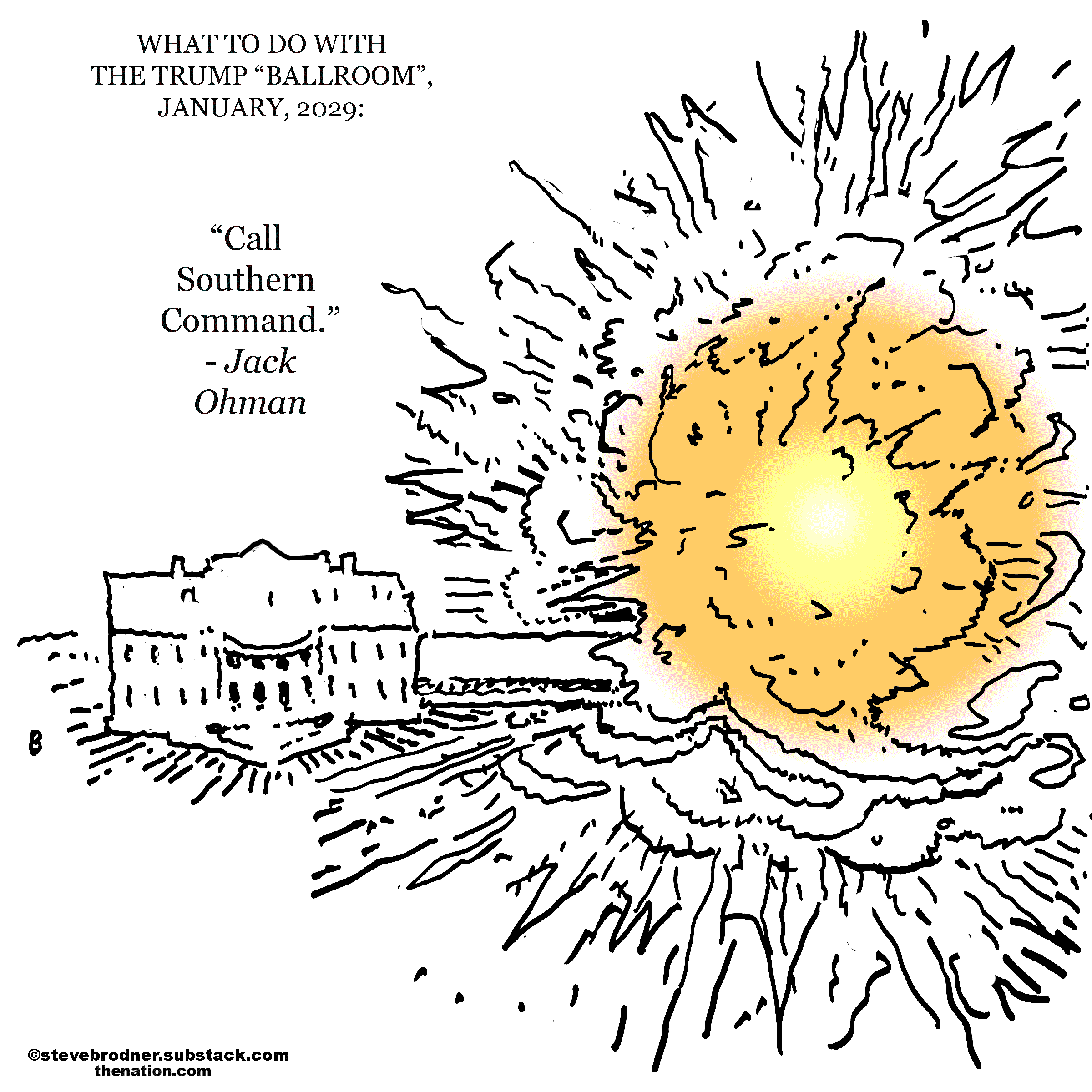
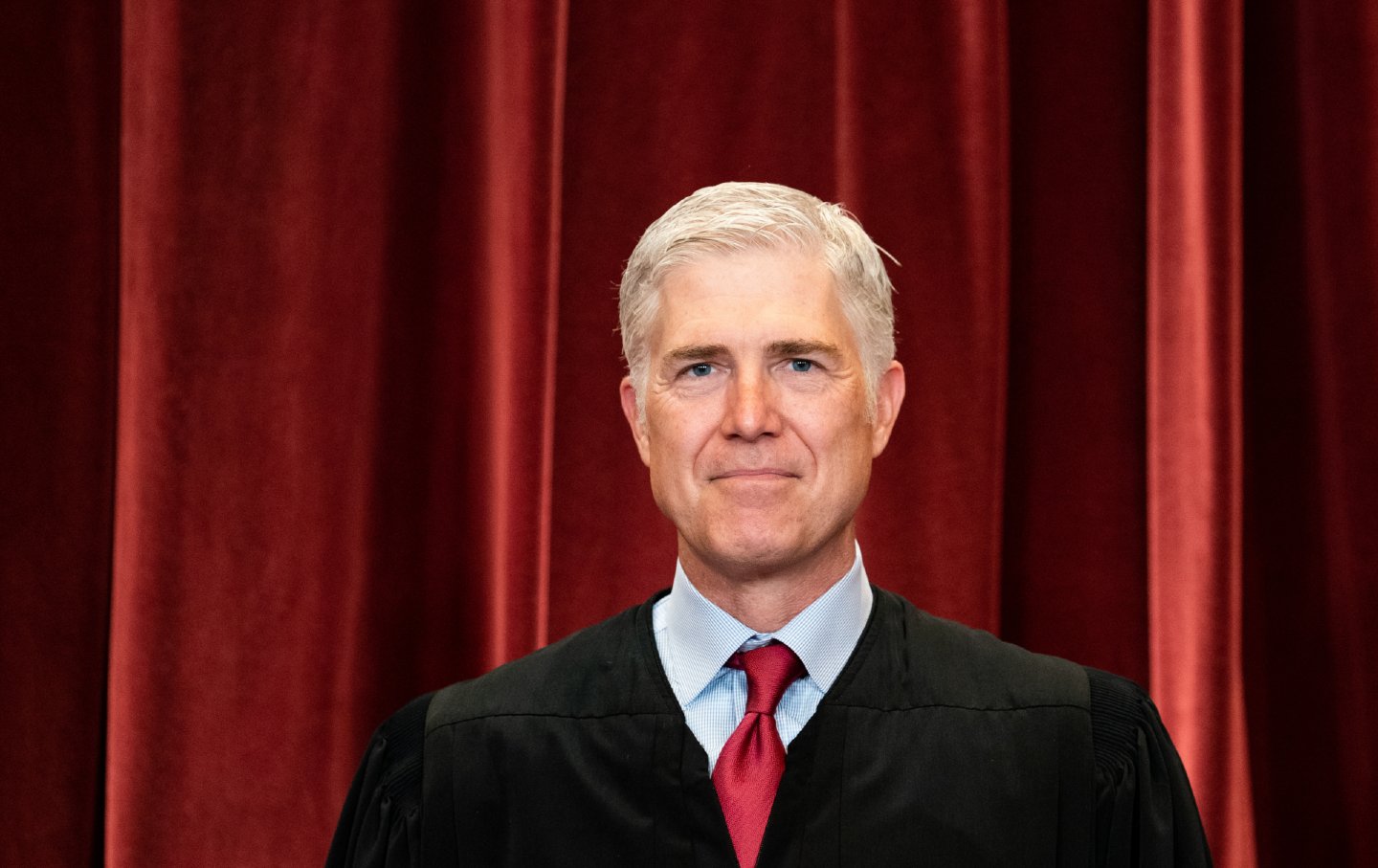
The Supreme Court Has a Serial Killer Problem The Supreme Court Has a Serial Killer Problem
In this week's Elie v. U.S., The Nation’s justice correspondent recaps a major death penalty case that came before the high court as well as the shenanigans of a man who’s angling...
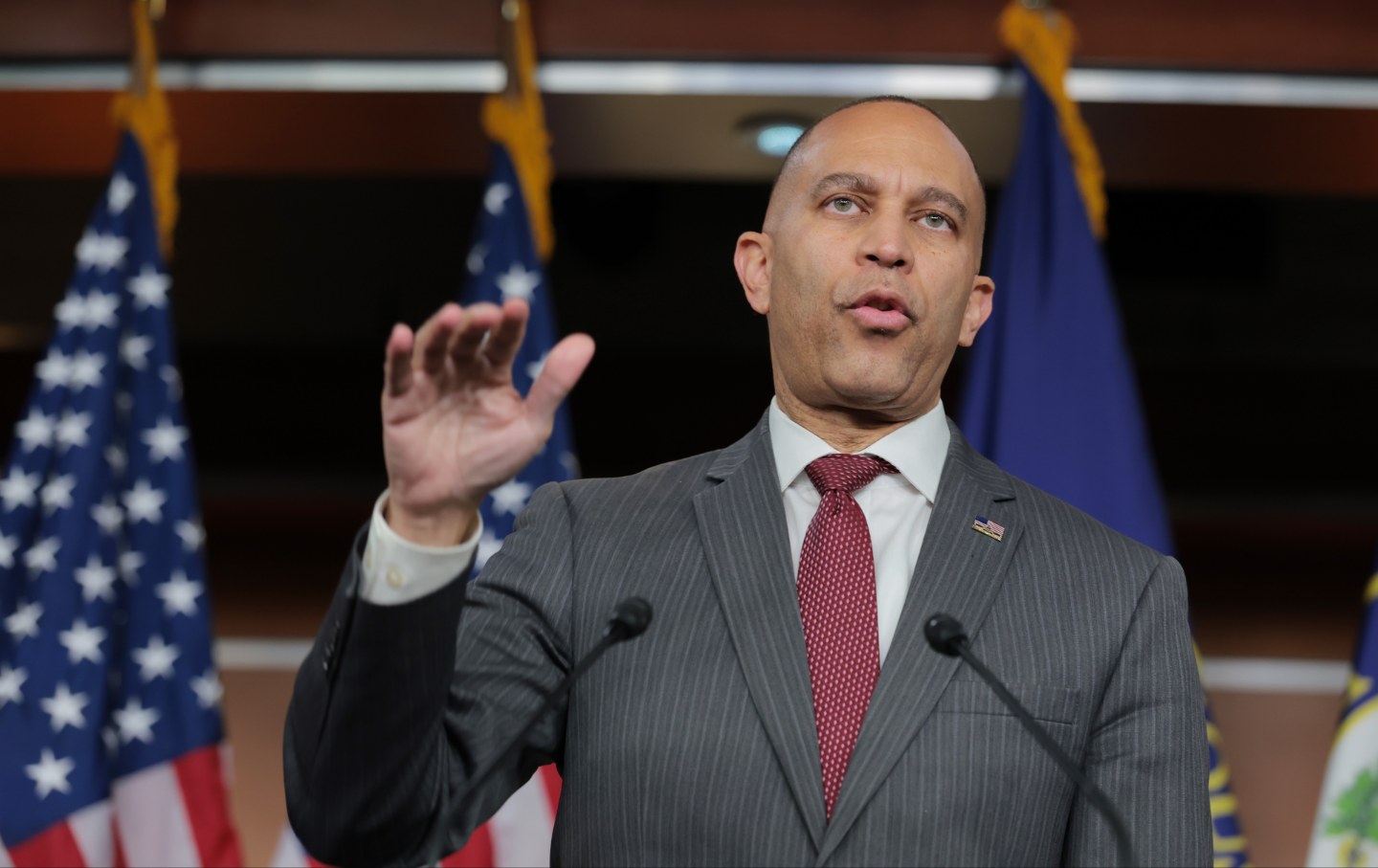
Corporate Democrats Are Foolishly Surrendering the AI Fight Corporate Democrats Are Foolishly Surrendering the AI Fight
Voters want the party to get tough on the industry. But Democratic leaders are following the money instead.

Marching Against a Corrupt Regime Marching Against a Corrupt Regime
People taking to the streets for democracy.
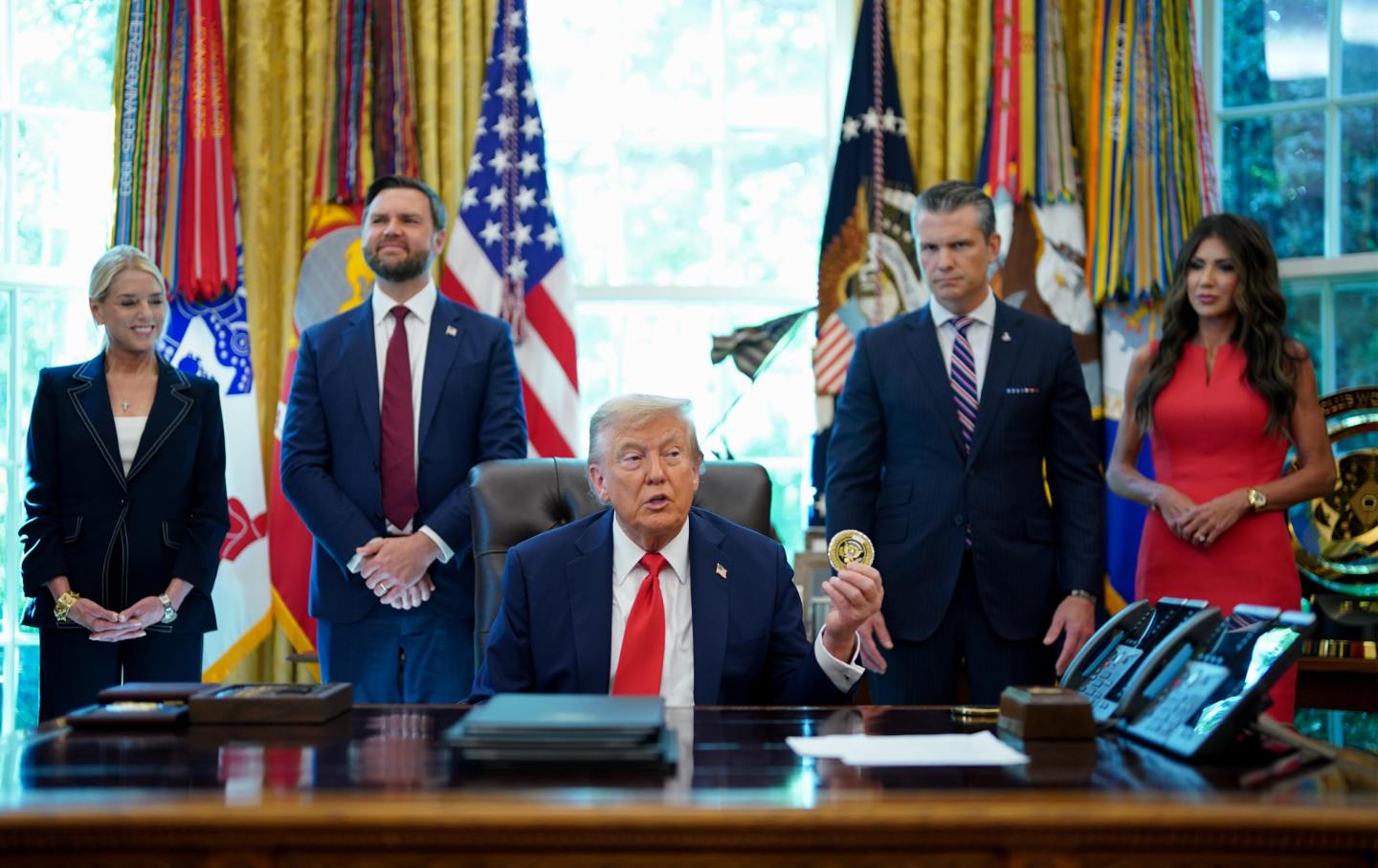
It Would Be Madness to Give Trump and His Toadies Even More Power It Would Be Madness to Give Trump and His Toadies Even More Power
And yet, that’s what the Supreme Court appears prepared to do.

Trump Is Dragging Republicans to Crushing Defeat After Crushing Defeat Trump Is Dragging Republicans to Crushing Defeat After Crushing Defeat
The president is deeply unpopular, his policies are failing, and Republicans are losing—everywhere.


